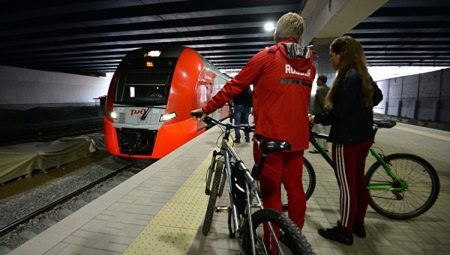In the summer, an increasing number of cyclists are faced with the question of whether it is possible to transport a two-wheeled vehicle in an electric train. The answer to this question is not so simple, as the situation has a lot of nuances.
Basic Rules
Transportation of a bicycle in a commuter train is possible both in a paid and in a free format. However, it is important to mention that Russian Railways prohibits the transport of dirty objects, so the vehicle will either have to be wiped off before boarding, or it must be provided with a bag of the appropriate size or package. In principle, bicycles can be transported both in the vestibule, and in places for hand luggage, and in free space at the beginning and end of the car, but the conditions of carriage in these cases differ.
The system operates in such a way that every person who has bought a boarding pass has the right to carry free hand luggage. If the bike fits its characteristics, nothing more is needed.

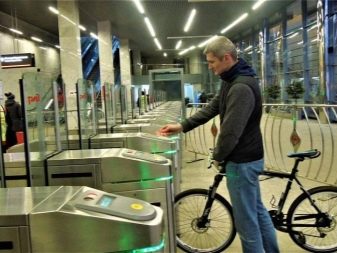
All stocks, specific tariffs and conditions vary in different regions of the Russian Federation. In addition, the further a person travels, the more expensive it will cost to transport a bicycle. If the bike in any way can damage the things of other passengers or even injure them, then transportation is in principle prohibited. If controllers express dissatisfaction before landing, then It is recommended to immediately unfasten the front wheel and notify employees that the bicycle will be placed as hand luggage.
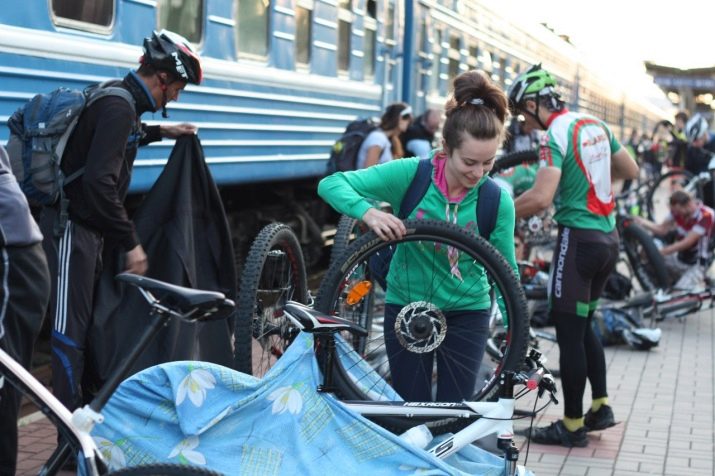
Is it free
The baggage rules, which are relevant for trains, indicate that only hand luggage can be carried for free.Thus, the owner of each ticket, including a child’s ticket, with a seat provided, can occupy the space reserved for baggage, without additional charge. It is important that the sum of the three dimensions of each object does not go beyond the borders of 180 centimeters, and the weight of each element does not exceed 35 kilograms.
For an additional cost you can carry another 50 kilograms of baggage weight. The exact conditions can be clarified on the information stand, usually located in each car.
Transportation of a bicycle must be paid when the sports equipment exceeds the standard for measurements, that is, it goes beyond the boundaries of 180 centimeters. We are talking about a bicycle, devoid of motor and in disassembled condition.
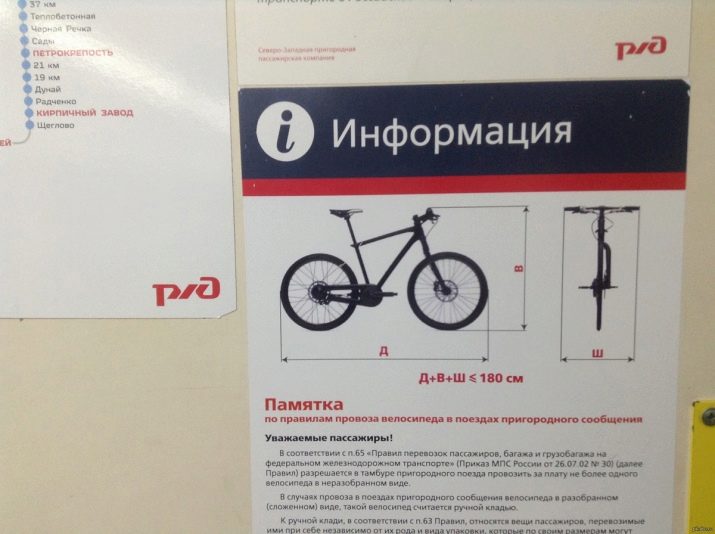
The transportation procedure is determined in such a way that the two-wheeled vehicle is located either in the cabin for hand luggage or next to passengers. Of course, in the second case, the transported bicycle should not interfere with the "neighbors" by train. The fee for each bike is the same as the baggage rate of 10 kilograms.
It must be mentioned that in the summer, some carriers organize promotions for cyclists that are relevant on certain days or hours. Usually their essence lies in the fact that when buying a regular ticket for a passenger, any bike is transported for free. For example, it can be a period from June 10 to October 31, during which any passenger can transport his vehicle unassembled at no extra charge.
At all, Each region has its own specific transport. In the Krasnoyarsk Territory, the assembled bike is allowed to be transported only in the vestibule, paying an additional 19 rubles. In the Altai Territory, from May 10 to September 30, a special offer is valid, according to which, when buying a ticket for a passenger, he can carry a bicycle for free. Such benefits usually apply only to the territory of a particular region, so you need to find out about them in advance at the box office of the railway station or on the website of the transport company.

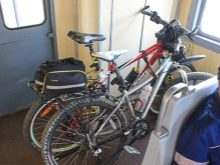
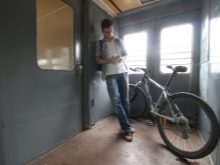
In the electric trains of OJSC CPPK, it is possible to transport the bicycle free of charge assembled daily from 11 a.m. to 4 p.m., and also from 9 p.m. to 6 a.m. However, this is possible only if both the start and end points are in Moscow, Moscow Region or the Moscow Region. You need to take a special free ticket to the bike at the box office, without which access to the car is prohibited. The document is executed in the terminal and is received only at current hours, that is, from 11 to 16 hours and from 21 to 6 hours. In the terminal, the menu item “Hand baggage” or “Baggage” is selected, after which the item “Bicycle 0” is selected. Paid transportation of the bike is paid either before the trip, or directly in the train with the assistance of the conductor.
In those days when public events are held in Moscow, for example, “Bicycle Parade” or “To Work by Bicycle,” Russian Railways allows you to travel with a vehicle for free at any time of the day. Such information must first be specified on special information stands.
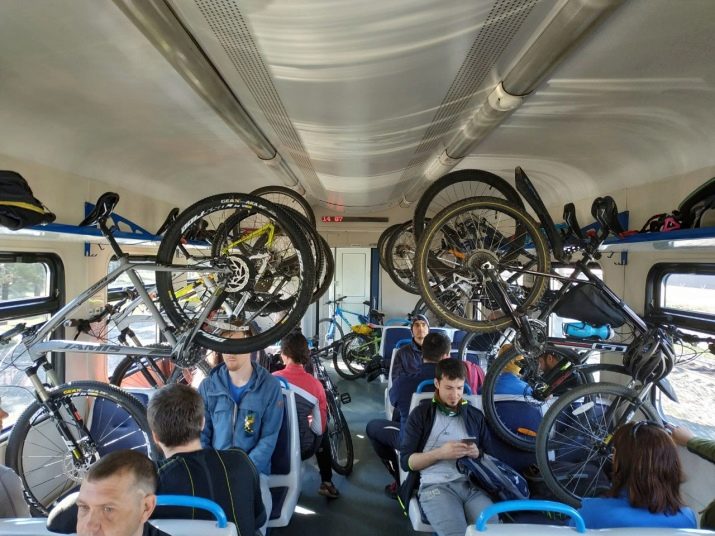
Returning to the CPPK, paid transportation costs from 60 to 120 rubles, depending on the direction of movement and the distance along the way. Up to 100 kilometers, the tariff corresponds to 60 rubles, and over 100 kilometers - 120 rubles. For other carriers, the cost is basically the same. For example, at MT PPK for transportation over a distance of 100 kilometers, you will have to pay 25 rubles, and over 100 kilometers - already 50 rubles.
At Aeroexpress, bicycle transportation is free in any form throughout the day.
The fine for stowaway baggage is usually 100 rubles and is considered an administrative violation. However, some conductors are unauthorized and require free riders to pay an amount equal to a regular passenger ticket.
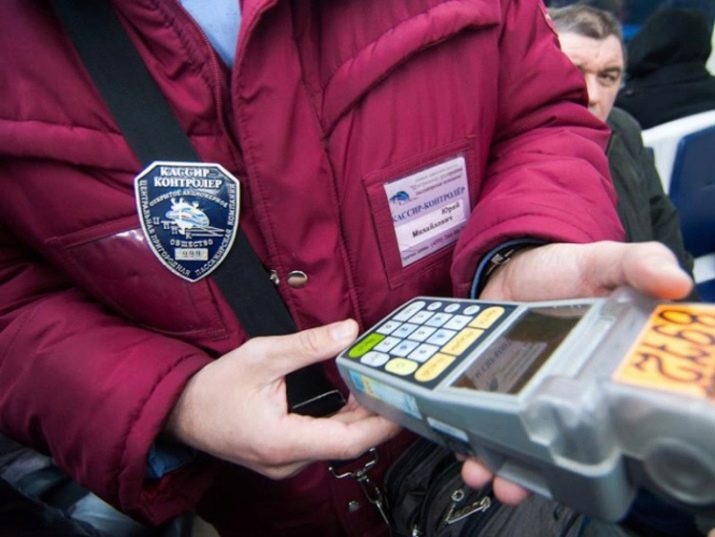
Where to put the bike
Experienced cyclists recommend not traveling with a large bicycle company in one car, as this creates a queue and takes up too much space.
It will be correct to suspend the vehicle by the saddle on the upper luggage rack and securely fasten the seat post. Quite often, a bicycle is mounted on a shelf using a bicycle lock.
If you choose the right seat, then no problems with the controller or with other passengers should arise. Some trains are equipped with special areas designed for bulk cargo. Sometimes, by the way, they are present only in some wagons, so it makes sense to go around the train and find the best place.

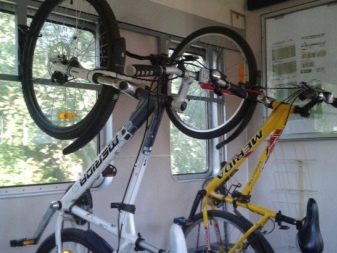
If the car is practically empty, then the bike is allowed to be placed between the seats in the normal or inverted state. The bike should not be left in the vestibule, as this will interfere with incoming and outgoing fellow travelers. It can also be stolen corny. An exception may be the first and last cars, but again in the case of low occupancy. It is worth mentioning that according to the rules, only one bike can be placed in one vestibule.
When it is decided to ride the company in one carriage, although this is undesirable, it is recommended to place the bicycles in a checkerboard pattern, that is, one bike becomes the rear wheel to the exit, and the second front wheel. Sometimes three vehicles are located below as a support, and at the top, if necessary, a couple more are fixed. In the upright position, it is not forbidden to place the rear wheel on the seat. It is also necessary to mention the importance of putting the device on the brake. To this end, the elastic band used to pull the brake handle to the steering wheel will help.



Packaging features
Only a folding bike that matches the dimensions of hand luggage will be able to transport free of charge in the train. In order to achieve the required sum of three dimensions, you will need to remove the front wheel, steering wheel and fold the structure. It must be mentioned that in modern models, the wheel is dismantled by pressing a convenient lever, which makes it unnecessary to carry tools. The pin either slides into the frame or is dismantled with the seat. In this form, the bike does not block the passage for other passengers and does not take up seat space. With a strong desire, you can even remove the pedals and rear wheel.
You can pack your bike in a regular bag or bag, or in a specially stitched case or even plastic wrap.
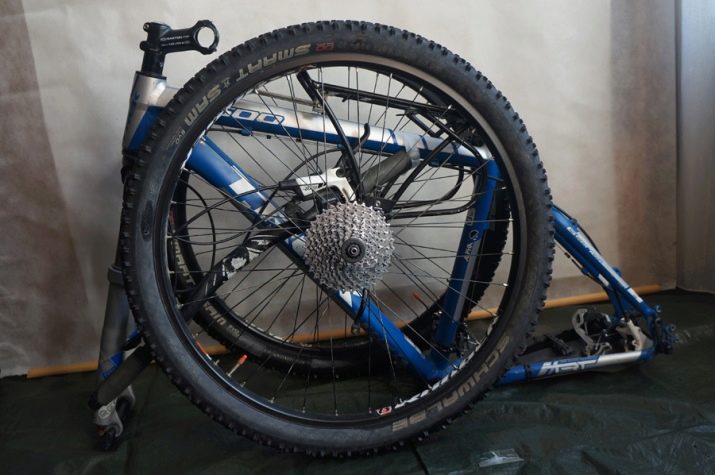



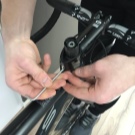

Recommended also Prepare luggage gum or other elastic ties in advance to fix the vehicle near the wall or seat handle. In order not to get your bag or bag dirty, wash your bike first. By the way, the cover itself must be soft, otherwise the protruding angular parts of the bicycle can disturb or even injure other passengers and their belongings. The bicycle is stacked with the wheels up in the cover: first, the rounded fabric part is put on the rear wheel, then it is partially fastened. After that, the front wheel and pedals are laid inside. The container for the bike must be selected so that the structure inside does not hang.
As for children's bicycles, they fall under all the above rules, and therefore, having the required dimensions and being packed, they can be transported as hand luggage. Here, again, luggage elastic bands, which are laces in a fabric braid with reliable metal hooks at both ends, are useful. They will help not only to fix, but also if necessary to use the parking brake.



You can see a very convenient way to transport bicycles in trains in the next video.
